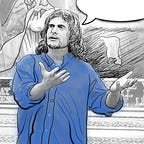Multiverse
The Canadian geese awaken me at sunrise, flying low over the forest, following the bend in the river, and honking to beat the band. I am cocooned in my sleeping bag, camped atop a picnic table in the Manitoba province of Canada, looking up at hundreds of goose bellies as they soar overhead. The sunlight slices through the forest mist as the geese sing, greeting the day. It is the best alarm clock ever.
As a small child, about four years of age, I was once terrorized by two geese. Mom had dressed me in my Sunday best and I was walking along the edge of Randolph Park Lake, feeding the ducks popcorn. Suddenly, two large geese waddled swiftly towards me. The geese were much taller than I was at the time and they began to bully me, working as a team. One goose would bite me with its hideous orange beak, chasing me around in screaming, frantic circles, while the other bird would gobble up all the spilled popcorn. It was horrible and humiliating.
The people of the Cheyenne, Arapaho, and Sioux, were continental citizens, making migrations that put them in the best parts of North America during the best parts of the year. Geese are also continental citizens, with no respect for international borders, continually chasing the tilt of the planet. The geese make an amazing journey, storing all the corn and sunshine that their feathered bodies can hold, and hauling it north to the arctic spring where they nest amidst crevices of ice and silence, manufacturing newborn goslings from all that stored energy
I remember one hot summer afternoon that I was fortunate enough to spend in Montana. I was walking along a marshy lake, spooking up waterfowl — duck, heron, crane, kingfisher, and loon — when suddenly I came upon an elderly gentleman fishing without a pole. He was a Native American, and I assume a Blackfoot because I was on the Blackfoot reservation but you never know and besides I did not ask.
He told me that the bird his people most revere is not the eagle, but that they consider the most sacred of birds to be our web footed friend — the duck. The Blackfoot admire ducks because of the long seasonal migrations which they undergo. Like geese, ducks are continental citizens, following the spring thaw and autumn harvest. The Blackfoot reason that seeing so much of the world must make them wise.
“And another thing,” he said to me as I was about to leave, “I do not live in a universe. I live in a multiverse.”
That Manitoba morning when the low flying geese woke me up after the echoes of their song faded into the white water roar of the river, I sat up. Watching the geese fly into the heart of the sunrise; I was startled to discover a line of tiny muddy footprints, the trail of a small beast, a mammal, the size perhaps of a squirrel or weasel, leading from my toes to my head. While I had been sleeping some wild beast had crept across my body, stared into my eyes, tasted my breath, and maybe even read my dreams. For a brief moment, I wondered if this wild beast found my dreams to be either inspiring or mundane, or if my civilized wishes were even understandable to this wild cousin.
I am awakened by this flock of geese flying overhead our paths intersecting for a brief moment in the sunshine mist of a Manitoba morning. Sunlight paints the earth and the new day is full of possibilities. I have no idea of where the geese have come from or where they are going, just enjoying my beautiful alarm clock. I too live in a multiverse.
